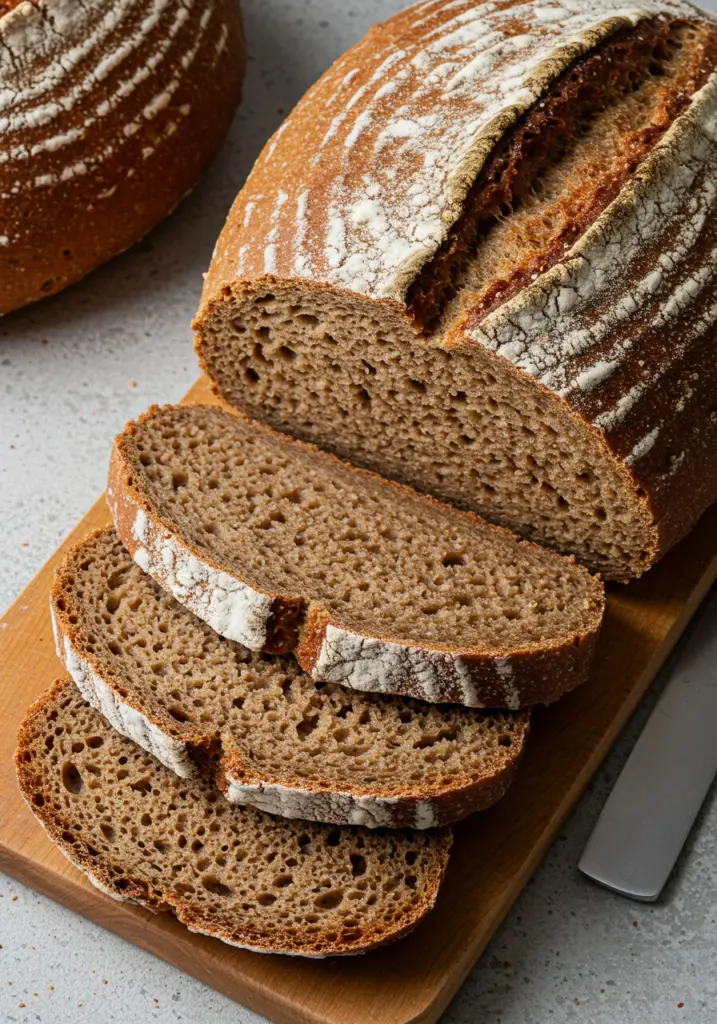German Rye Bread, or Roggenbrot, is a classic staple in German cuisine. This hearty, slightly tangy bread is known for its dense crumb, dark crust, and rich flavor. Made primarily with rye flour, it’s perfect for sandwiches, toast, or simply slathered with butter. Unlike many fluffy white breads, Roggenbrot is deeply satisfying, nutritious, and keeps well for days.
Want recipes like this delivered straight to your inbox? Subscribe now to get the latest culinary creations you’ll love.
Why You’ll Love This Recipe
Hearty & Nutritious – Packed with fiber and flavor from whole rye flour.
Long-Lasting Freshness – This bread stays moist and delicious for days.
Perfect for Sandwiches – Holds up well to spreads, meats, cheeses, or veggies.
Traditional Taste – Brings the classic flavors of Germany into your kitchen.
Naturally Vegan – No eggs or dairy needed for this robust bread.
Ingredients You’ll Need
For the Starter (Preferment):
- 1 cup rye flour
- ½ cup lukewarm water
- ¼ tsp instant dry yeast
For the Dough:
- All of the prepared starter
- 2 cups rye flour
- 1½ cups bread flour (or all-purpose flour)
- 1½ tsp salt
- 1 tsp sugar or honey
- 1 tsp caraway seeds (optional, for authentic flavor)
- 1½ tsp instant dry yeast
- 1¼ cups warm water
For Topping (Optional):
- Extra caraway seeds
- Light dusting of flour
Tools You’ll Need
- Large mixing bowl
- Dough whisk or wooden spoon
- Loaf pan or baking sheet
- Kitchen towel or plastic wrap
- Oven with steam (or a pan of hot water to create steam)
- Wire rack for cooling
Step-by-Step Instructions
Step 1: Make the Starter (Preferment)
- In a bowl, mix 1 cup rye flour, ½ cup lukewarm water, and ¼ tsp yeast until a thick paste forms.
- Cover the bowl loosely and let it sit at room temperature for 12–16 hours (overnight is ideal).
- You’ll know it’s ready when it’s slightly risen and has a pleasant, sour aroma.
Step 2: Prepare the Dough
- In a large mixing bowl, combine the starter with the remaining rye and bread flour.
- Add in the salt, sugar (or honey), caraway seeds, and yeast.
- Pour in the warm water gradually, mixing with a spoon or dough whisk until a sticky dough forms.
- This dough will be dense and sticky—it doesn’t need kneading like white bread.
Step 3: First Rise
- Cover the bowl with a towel or plastic wrap.
- Let it rise in a warm place for 1 to 1½ hours, until slightly puffy. It won’t double like regular bread, and that’s okay.
Step 4: Shape the Dough
- Flour your hands and lightly flour a surface.
- Turn the dough out and shape it into a loaf or round boule.
- Place it into a greased loaf pan or onto a baking sheet lined with parchment.
- Sprinkle the top with a little flour or extra caraway seeds if desired.
Step 5: Final Rise
- Cover loosely and let rise again for 45–60 minutes.
- The dough should rise just a bit and appear airy.
Step 6: Bake the Bread
- Preheat your oven to 425°F (220°C). Place a pan of hot water at the bottom of the oven to create steam.
- Score the top of the loaf with a sharp knife to allow expansion.
- Bake for 35–45 minutes, until the crust is deeply brown and sounds hollow when tapped.
- Let the bread cool completely on a wire rack before slicing. This helps the crumb set properly.
Tips for the Best German Rye Bread
Use Steam – It helps develop a crispy crust and beautiful color.
Don’t Over-Knead – Rye dough is naturally sticky and needs minimal handling.
Let It Cool – Cutting too early can make the bread gummy inside.
Flavor Deepens with Time – Roggenbrot often tastes better the next day.
Store Well – Wrap tightly in a cloth or keep in a bread box to retain moisture.
Serving Suggestions
Traditional Open-Faced Sandwiches – Top with smoked salmon, sliced eggs, or pickled veggies.
Hearty Toast – Great with butter, cheese, or jam.
Soup Companion – Delicious served with lentil, potato, or split pea soup.
Rustic Snack – Pair with mustard, sliced beef, or hard cheeses for a simple lunch.
How to Store & Reheat
Storing:
- Room Temperature: Wrap in a clean towel and store in a bread box for up to 4–5 days.
- Freezing: Slice and freeze in a zip-top bag. Reheat slices in the toaster when needed.
Reheating:
- Toaster: Best way to reheat individual slices.
- Oven: Wrap in foil and warm at 300°F (150°C) for 10–15 minutes.
Frequently Asked Questions
1. Can I make this bread without caraway seeds?
Yes! Caraway adds a traditional flavor, but it’s totally optional.
2. Is rye flour gluten-free?
No, rye contains gluten, though less than wheat. If you need a gluten-free bread, try a certified GF recipe.
3. Can I use 100% rye flour?
You can, but the bread will be very dense and won’t rise as much. Mixing with bread flour improves texture and rise.
4. Can I make this with sourdough starter instead of yeast?
Absolutely! Replace the preferment with your sourdough starter and adjust the water and flour slightly.
Final Thoughts
German Rye Bread (Roggenbrot) is a celebration of old-world baking—simple ingredients, deep flavors, and timeless tradition. It’s more than just bread; it’s comfort, history, and nourishment in every bite. Whether you enjoy it for breakfast, as a sandwich, or alongside your favorite soup, this recipe will become a go-to in your kitchen.
Give it a try and experience the authentic taste of Germany from the heart of your home. Don’t forget to share your baking success with us and leave a review!
Preparation Time: 15 minutes (plus rising time)
Cooking Time: 45 minutes
Cuisine: German
Nutritional Information (Per Serving):
Calories: 180 | Protein: 5g | Carbohydrates: 35g | Fat: 1.5g | Fiber: 5g | Sodium: 280mg

German Rye Bread (Roggenbrot)
- Total Time: 1 hour
Description
German Rye Bread, or Roggenbrot, is a classic staple in German cuisine. This hearty, slightly tangy bread is known for its dense crumb, dark crust, and rich flavor. Made primarily with rye flour, it’s perfect for sandwiches, toast, or simply slathered with butter. Unlike many fluffy white breads, Roggenbrot is deeply satisfying, nutritious, and keeps well for days.
Want recipes like this delivered straight to your inbox? Subscribe now to get the latest culinary creations you’ll love.
Ingredients
For the Starter (Preferment):
-
1 cup rye flour
-
½ cup lukewarm water
-
¼ tsp instant dry yeast
For the Dough:
-
All of the prepared starter
-
2 cups rye flour
-
1½ cups bread flour (or all-purpose flour)
-
1½ tsp salt
-
1 tsp sugar or honey
-
1 tsp caraway seeds (optional, for authentic flavor)
-
1½ tsp instant dry yeast
-
1¼ cups warm water
For Topping (Optional):
-
Extra caraway seeds
-
Light dusting of flour
Instructions
Step 1: Make the Starter (Preferment)
-
In a bowl, mix 1 cup rye flour, ½ cup lukewarm water, and ¼ tsp yeast until a thick paste forms.
-
Cover the bowl loosely and let it sit at room temperature for 12–16 hours (overnight is ideal).
-
You’ll know it’s ready when it’s slightly risen and has a pleasant, sour aroma.
Step 2: Prepare the Dough
-
In a large mixing bowl, combine the starter with the remaining rye and bread flour.
-
Add in the salt, sugar (or honey), caraway seeds, and yeast.
-
Pour in the warm water gradually, mixing with a spoon or dough whisk until a sticky dough forms.
-
This dough will be dense and sticky—it doesn’t need kneading like white bread.
Step 3: First Rise
-
Cover the bowl with a towel or plastic wrap.
-
Let it rise in a warm place for 1 to 1½ hours, until slightly puffy. It won’t double like regular bread, and that’s okay.
Step 4: Shape the Dough
-
Flour your hands and lightly flour a surface.
-
Turn the dough out and shape it into a loaf or round boule.
-
Place it into a greased loaf pan or onto a baking sheet lined with parchment.
-
Sprinkle the top with a little flour or extra caraway seeds if desired.
Step 5: Final Rise
-
Cover loosely and let rise again for 45–60 minutes.
-
The dough should rise just a bit and appear airy.
Step 6: Bake the Bread
-
Preheat your oven to 425°F (220°C). Place a pan of hot water at the bottom of the oven to create steam.
-
Score the top of the loaf with a sharp knife to allow expansion.
-
Bake for 35–45 minutes, until the crust is deeply brown and sounds hollow when tapped.
-
Let the bread cool completely on a wire rack before slicing. This helps the crumb set properly.
Notes
Use Steam – It helps develop a crispy crust and beautiful color.
Don’t Over-Knead – Rye dough is naturally sticky and needs minimal handling.
Let It Cool – Cutting too early can make the bread gummy inside.
Flavor Deepens with Time – Roggenbrot often tastes better the next day.
Store Well – Wrap tightly in a cloth or keep in a bread box to retain moisture.
- Prep Time: 15 minutes (plus rising time)
- Cook Time: 45 minutes
- Cuisine: German



